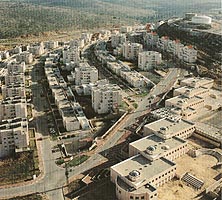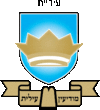Modiʿin illite
|
Modiʿin illite מוֹדִיעִין עִלִּית موديعين عيليت |
||
|
||
 Modiʿin Illit 2008 |
||
| Territory : |
West Bank ( Judea and Samaria ) |
|
| Community type : | City administration | |
| Founded : | 1994 | |
| Coordinates : | 31 ° 56 ' N , 35 ° 3' E | |
| Height : | 319 m | |
| Area : | 4.746 km² | |
| Residents : | 64,179 (2015) | |
| Population density : | 13,523 inhabitants per km² | |
| Mayor : | Jaakov Gutterman | |
| Website : | ||
|
|
||
Modiʿin Illit ( Hebrew מודיעין עילית), also Kirjat Sefer ( Hebrew קריית ספר), is a city and Israeli settlement in the West Bank . It was founded in 1994 and is located about halfway between Tel Aviv and Jerusalem around 6 kilometers from the Israeli city of Modi'in .
Modiʿin Illit is the largest Israeli settlement in the West Bank with 64,179 inhabitants (end of 2015), mostly ultra-Orthodox Jews . It is east of the Green Line . The barrier built by Israel has the shape of a wall near Modi'in Illit and separates the West Bank from Modi'in Illit.
Surname
Modiʿin Illit, German Ober-Modiʿin, was named after the city of Modiʿin in Israel, a good 6 kilometers away. Most Haredim call it Kirjat Sefer , although the government commission for the allocation of names has declared this name invalid for two reasons: Firstly, Kirjat Sefer was the name of the construction company that built the settlement, and secondly there is the biblical Kirjat Sefer far from today's settlement of the same name. Therefore the name was officially changed, and Kirjat Sefer is referred to as Modi Illin Illit together with the nearby Achusat Brachfeld and Gane Modiʿin , analogous to the name of the local association.
history
The settlement was founded as an independent settlement by four ultra-Orthodox local politicians. The aim was to ease the cramped housing situation in the ultra-orthodox metropolitan areas of Bnei Berak and Jerusalem .
geography
Modiʿin Illit is about halfway between Tel Aviv and Jerusalem near the city of Modi'in on the Israel-facing western side of the Israeli barriers , which surround the place so spaciously or after completion that it can still expand considerably . The zoning plan of the Ministry of Construction from 1998 provides for the construction of a further 1200 houses for the region of Modiʿin Illit by 2020.
Legal status
According to the Israeli view, Modi'in Illit is one of the settlements that must remain within Israel if a peace solution is found in the Israeli-Palestinian conflict . The request of the Israeli governments in the negotiations for a two-state solution was supported by several US presidents, including Bill Clinton in 2000.
According to a report by the Israeli organization Shalom Achshaw , 44.57 percent of the land on which the city was built is privately owned by Palestinians , in violation of Israeli law. Since a 1979 ruling by the Israeli Supreme Court , no Israeli settlements have been allowed to be built on privately owned Palestinian land. However, the Israeli military administration in the Occupied Territories, on whose statistics the report is based, denies that the report accurately reflects the reality.
population
In 2006 the city had a birth rate of eight children per woman, the highest in Israel. It is well above the average for Germany (1.37) and Israel (2.9), it even exceeds the usual values in Africa and represents one of the highest values in the industrialized countries.
| year | Residents | increase |
|---|---|---|
| 1994 | 2,400 | - |
| 1995 | 5,500 | 129% |
| 1996 | 6,150 | 11.8% |
| 1997 | 8,090 | 31.5% |
| 1998 | 10,500 | 29.7% |
| 1999 | 13,000 | 23.8% |
| 2000 | 16,400 | 26.1% |
| 2001 | 19,200 | 17.0% |
| 2002 | 22,000 | 14.5% |
| 2003 | 24,290 | 10.4% |
| 2004 | 27,386 | 12.7% |
| 2005 | 28,500 | 4.0% |
| 2006 | 34,500 | 13.1% |
| 2007 | 38,100 | 10.4% |
| 2008 | 41,900 | 10.0% |
| 2009 | 46,200 | 13.2% |
References
See also
Web links
Footnotes
- ↑ Archived copy ( Memento of the original from May 17, 2018 in the Internet Archive ) Info: The archive link was inserted automatically and has not yet been checked. Please check the original and archive link according to the instructions and then remove this notice. Retrieved March 3, 2017
- ^ Settlements in the West Bank. (No longer available online.) Foundation for Middle East Peace, archived from the original September 4, 2014 ; accessed on June 25, 2012 . Info: The archive link was inserted automatically and has not yet been checked. Please check the original and archive link according to the instructions and then remove this notice.
- ↑ http://www.haaretz.com/print-edition/news/documents-reveal-w-bank-settlement-modi-in-illit-built-illegally-1.61686
- ↑ Martin Klingst: The struggle for Palestine. 2000 - Clinton. In: The time . April 22, 2004. Retrieved June 28, 2012 .
- ^ Peace Now's Settlement Watch Team: Breaking the Law in the West Bank. One Violation Leads to Another: Israeli Settlement Building on Private Palestinian Property. (PDF; 388 kB) Peace Now, October 2006, p. 24 , accessed on June 25, 2012 (English).
- ^ Rory McCarthy: 39% of Israeli settlements 'on private land'. In: The Guardian . November 22, 2006, accessed May 9, 2012 .
- ^ Nadav Shragai: Blow to settlement movement. In: Haaretz . November 21, 2006, accessed May 9, 2012 .
- ↑ Nadav Shragai: Peace Now: 40 percent of settlements' land is owned by private Palestinians. In: Haaretz . November 22, 2006, accessed May 9, 2012 .


